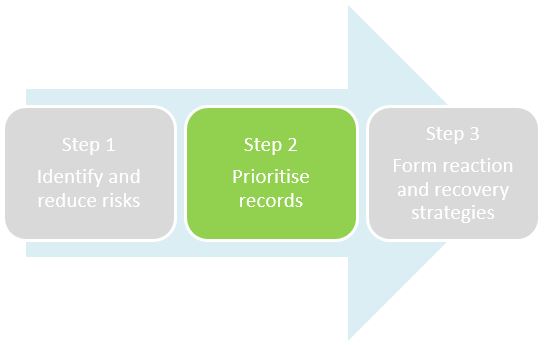About: This advice refers to physical records. The storage of digital records on network servers, in data centres, or in the cloud is NOT covered by the scope of this guidance. The protection and recovery of digital records needs be addressed within your Public Office’s business continuity plan.
Step 2. Prioritise records for salvage

The need to establish priorities is critical for disaster response as the opportunity to successfully salvage and recover records rapidly decreases after the first 48 hours.
Only a small portion of records support critical business or have continuing value. These records should be given the highest priority for salvage and recovery. Information on the retention requirements of records will assist salvage efforts.
Priority lists need to clearly outline which records to protect and salvage first and document their storage locations. A rating of low, medium or high priority would ideally be applied to all records not just those on the priority list.
High priority records can be protected through:
- Storage protections such as use of fire-proof vaults or archival packaging material
- Digitisation or copying to create back-up versions of the documents
- Transfer of records identified as State archives the State Archives Collection.
4.1 What to prioritise?
Priority records including high value and high risk records are identified through functional analysis, recordkeeping requirements, and implementation of retention and disposal authorities.
Priority records will include:
- State archives
- records with long retention periods
- highly sensitive or security classified records
- records critical to business continuity and restoring operations, such as contracts, legal documents, policies, financial and employee records, and
- recordkeeping control documents e.g. registers, catalogues, and indexes.
The following records are not priorities for recovery:
- time-expired records due for destruction
- short term temporary records
- published material where copies exist in other collections
- duplicated records, and
- records that have been digitised or copied where the original paper-based record has no discrete value or may be disposed of under GA45.
Access restrictions and security requirements applied to records should also be considered and where appropriate noted on the list.
4.2 Sentence records before a disaster strikes
The Standard on records management outlines the needs for regular application of retention and disposal authorisation. Timely sentencing of records reduces unnecessary holdings and avoids public offices undertaking needless recovery efforts, saving time and money.
4.3 CASE STUDY ‘UNSENTENCED’ RECORDS DAMAGED IN STORM
A public office based in a regional centre was involved in a records disaster after being hit by a massive storm. The public office has multiple sites and records storage areas within the region and beyond.
The storm event impacted many homes and businesses in the local area with power supply and road access also affected. Hence, a lowered level of community assistance was available, and several staff members were also caught up in the event.
Naturally the public office’s top priorities were to re-establish business operations and focus on delivering front line services to assist with community recovery. Records were not at the top of the priority list.
The records management unit’s immediate focus was to check the primary storage areas and to ensure recordkeeping systems were operational; these were fortunately unaffected by the event.
With all the chaos approximately three days passed until a staff member thought to check on records stored on smaller sites. To their horror they found a mould infestation within one of the records storage buildings.
Gutters had overflowed during the storm and water had leaked into the building. The wet records left unnoticed in humid conditions had grown mould, and there was an extensive mould infestation in the storage area. Given mould had already begun to grow it was too late to ‘simply’ dry the items. If recovery was required it was now a big salvage and recovery operation.
Records had not been sentenced prior to being placed into storage. Therefore, records could not be prioritised for recovery or authorised for destruction. To make matters worse the public office did not have a retention and disposal authority.
All records had to be dried, treated and recovered. This was a costly exercise. The public office had to commission a recovery services vendor to treat the mould. Meanwhile, internal resources needed to be re-allocated to prioritise the development of a retention and disposal authority.
Once the records were recovered, sentencing determined that most records were temporary, time-expired and due for destruction, meaning the recovery efforts were largely wasted. Records could been have destroyed before or immediately after the disaster, if retention requirements were determined prior to the disaster occurring and avoiding much unnecessary effort and expense.
The silver lining here was that the public office had appropriate insurance coverage, if not they would have suffered significant financial loss.
Knowing your retention requirements before placing records into storage will greatly reduce recovery efforts should your public office be caught up in a disaster.
- know the activities and transactions performed by your organisation and the resulting records created
- ensure all activities and resulting records are covered by Retention and disposal authorities
- sentence your records periodically
- ensure records of your sentencing determinations can be made assessable during a disaster (i.e. know which records have been sentenced and be able to easily identify those records which are critical to ongoing business or required as State archives)
- create an inventory of records series/ retention periods, and rank by importance (TIP: refer to risk register and retention and disposal authorities)
- identify State archives and records relating to business critical areas and document their storage locations
- destroy time-expired records
- make sure you monitor your storage areas before and after severe weather events.
The above factors are outlined in further detail within the Standard on records management and Standard on physical storage of State records.

